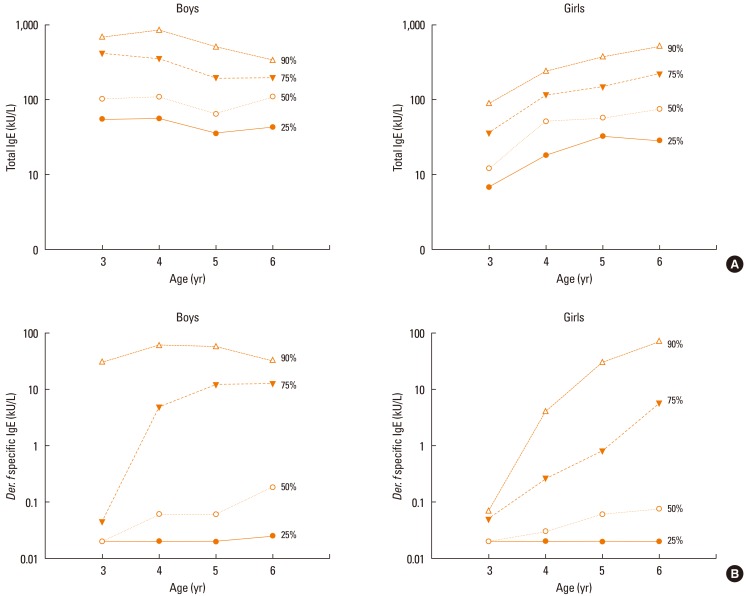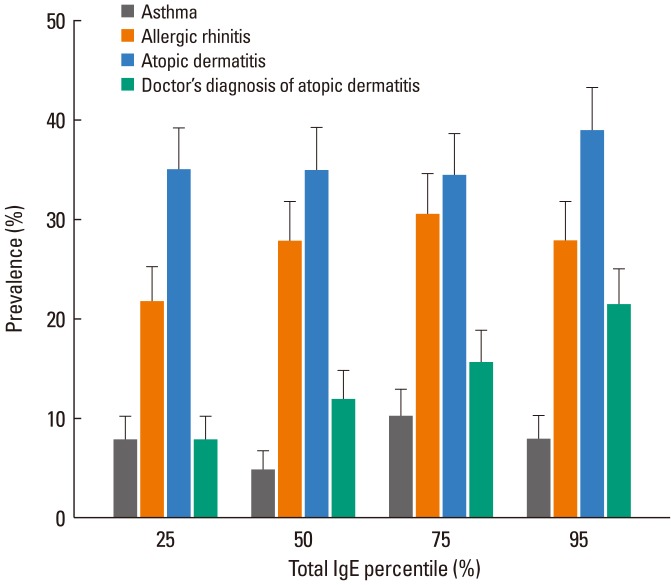Abstract
Purpose
Childhood allergies are a serious problem, as they may lead to lifetime chronic disease. Determination of total and specific IgE levels is known to be a diagnostic tool for allergic sensitization; however, IgE levels are affected by various factors, such as age, sex, ethnicity, and geographic area. Thus, we evaluated the distribution of total and specific serum IgE levels against seven inhalant allergens in preschool children and examined their association with allergic diseases in Seoul, Korea.
Methods
Total/specific serum IgE determination and skin prick tests for seven common allergens were performed on 509 children aged 3 to 6 years from 16 child care centers in Seoul, Korea. Demographic characteristics were surveyed from parents using a modified International Study of Asthma and Allergies in Childhood (ISAAC) questionnaire. A diagnosis of atopic dermatitis was made by physicians.
Results
The geometric mean of total IgE was 80.48±3.80 kU/L in preschool children. IgE levels were higher in boys (boys, 102.34±3.52 kU/L; girls, 62.37±3.93 kU/L; P<0.001) and atopic subjects (atopic, 158.00±3.35 kU/L; non-atopic, 52.75±3.44 kU/L; P<0.001). An increased prevalence of atopy was associated with a high monthly household income (P=0.004) and higher maternal education level (above university-level education; P=0.009), as well as increased total IgE levels (P=0.036). Physician-diagnosed atopic dermatitis was associated with sensitization to inhalant allergens.
Conclusions
Total IgE levels were very high as compared with those in previous reports from other countries. The most common sensitized allergen was Dermatophagoides farinae, and the positive response rate peaked at age 3 years and was maintained thereafter, particularly in boys. Specific IgE levels for seven inhalant allergens varied with age in preschool children. Although further investigations are needed with a broad range of ages and various allergens, the distribution of the total and specific serum IgE levels in preschool children might help to serve as a reference value to diagnose atopy.
Keywords: Allergy, atopy, immunoglobulin E, inhalant allergen, preschool, prevalence
INTRODUCTION
Allergic diseases are increasingly becoming public health problems worldwide. Particularly, childhood allergies, such as asthma, allergic rhinitis, and atopic dermatitis, are more serious because they may lead to lifetime chronic disease.1-5 Although various factors have been shown to be involved in allergic diseases, including age, obesity, lifestyle, allergen, air pollution, and climate,6,7 the key factors underlying the development of allergic diseases have not been clearly determined. Allergic sensitization is known to be one of the potential factors associated with allergic diseases.8
Total IgE levels are known to be affected by various factors, such as age, sex, ethnicity, and geographic area,9-14 although total IgE values are not always dependent on specific IgE elevation, which mediates allergic sensitization.
Additionally, allergic sensitization for specific allergens is affected by other factors. For example, egg and milk sensitization occurs during childhood, but are outgrown with age in most cases. Conversely, new allergen sensitization may appear in adults, such as pollen sensitization, suggesting the occurrence of different allergen sensitization with age. However, some allergens remain persistent, leading to long-lasting allergic diseases through persistent allergen sensitization.15-19 Thus, it is necessary to determine what types of allergens are major factors in childhood allergies to establish guidelines for allergy prevention.
Thus, the present study was conducted to better understand the condition of allergic sensitization in preschool children aged 3 to 6 years and the association between serum total and specific IgE levels and the presence of allergic diseases.
MATERIALS AND METHODS
Study population
The subjects were preschool children aged 3 to 6 years who were recruited from 16 childcare centers in 9 administrative districts (gu) in Seoul, Korea. The nine gu were selected by income level (high, middle, and low), and the 16 centers were randomly chosen among 9 districts. A total of 590 participants were surveyed using a questionnaire, and blood samples were collected. The study was approved by the Institutional Review Board (2010-02 CON-14-P), and informed consent was obtained from the parents of the children.
Total/specific IgE levels and skin prick tests
Total and specific IgE levels were measured using the Immuno-CAP 1000 system (Aloka, Japan) and a UniCAP kit (Phadia AB, Uppsala, Sweden), respectively. Specific IgE levels and skin prick tests (SPTs) were determined for the following seven inhalant allergens: Dermatophagoides farinae (D. farinae), cockroach, dog dander, cat dander, alder, mugwort, and Alternaria alternate (A. alternata). The upper limit of the allergen-specific IgE assay was 100 kU/L. Atopy was defined as the presence of serum specific IgE (with a level of ≥0.35 kU/L) or a positive response to a skin prick test of ≥3 mm and allergen wheal size ≥histamine wheal size (allergen wheal diameters).
Assessment of allergic disease
A modification of the International Study of Asthma and Allergies in Childhood (ISAAC) questionnaire was used for the assessment of allergic diseases. The presence of asthma was defined if a child's parents reported "Yes" to the question, "Has your child had asthma diagnosed in the lifetime?" The presence of allergic rhinitis was defined if a child's parents reported "Yes" to the question, "Has your child had allergic rhinitis diagnosed in the lifetime?" Atopic dermatitis was also defined if a child's parents answered "Yes" to the question, "Has your child had AD diagnosed in the lifetime?" The presence of eczema was evaluated by a physician's based on physical examination.
Statistical methods
Total and specific IgE levels were distributed on a log normal scale. Therefore, total IgE levels were logarithmically transformed for statistical analyses. Differences in geometric mean concentrations of total IgE and the prevalence of specific IgE according to population characteristics were analyzed by a t-test and χ2 test, respectively. The association between allergic diseases and IgE was evaluated by logistic regression adjusted for age, sex, monthly income, maternal education level, body mass index, and a parental history of allergic diseases.
RESULTS
Characteristics of study populations
Patient demographic characteristics are described in Table 1. When categorized according to age, 19 participants were 3 years old, 140 participants were 4 years old, 172 participants were 5 years old, and 178 were 6 years old. The sex ratio was 1.06 (262 boys and 247 girls). Over 77% of participants reported a household income below 4,300 dollars per month. Sixty-four percent of mothers graduated from a university. Disease diagnoses based on questionnaires were as follows: atopic dermatitis was the most common disease (n=183, 35.9%), followed by allergic rhinitis (n=137, 26.9%) and asthma (n=39, 7.6%). The number of children with physician-diagnosed atopic dermatitis was 73 (14.3%), and 228 participants were found to be normal (44.7%).
Table 1.
Demographic features of the study population, aged 3 to 6 years
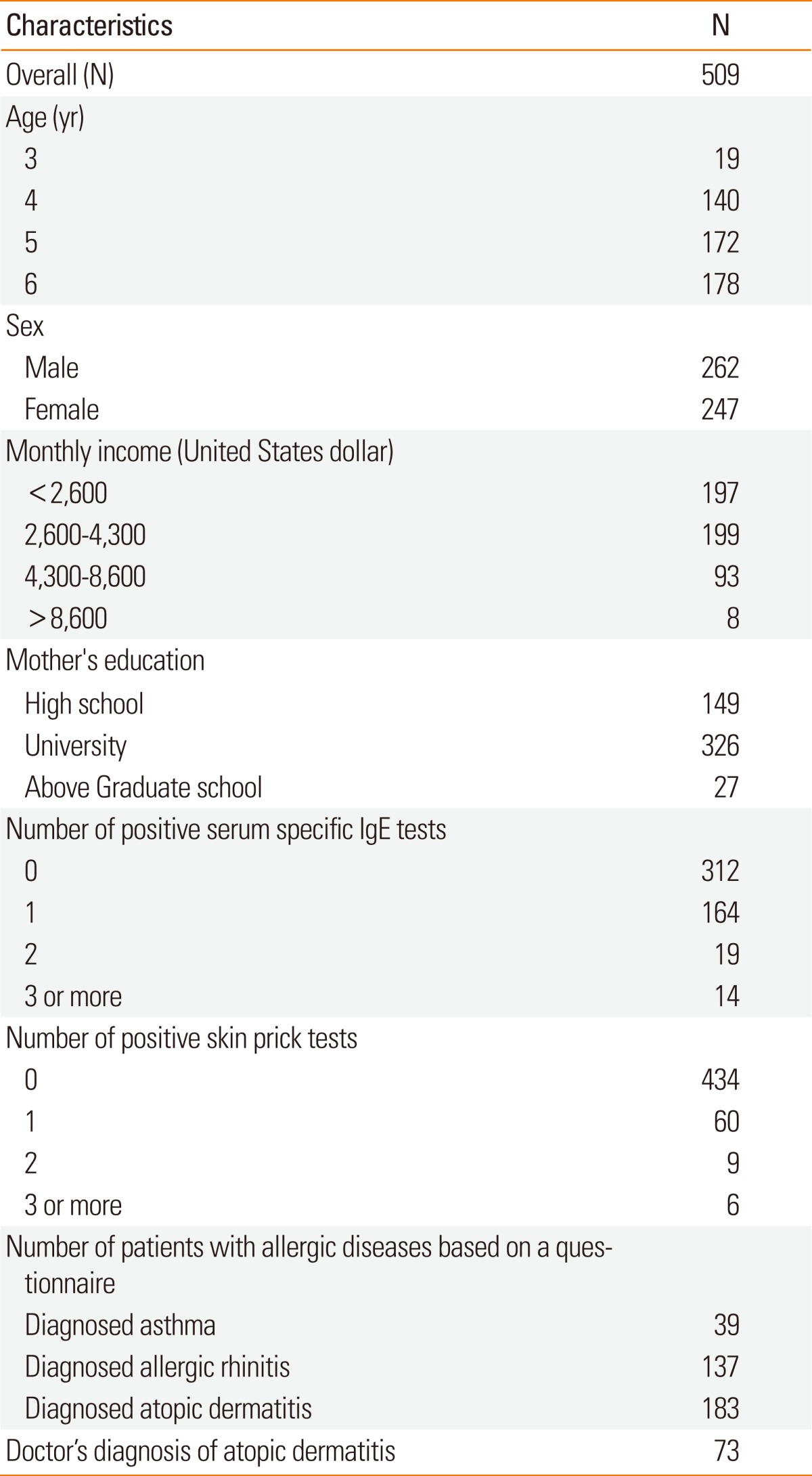
Distribution of total serum IgE levels according to independent predictors
Table 2 presents the distribution of total serum IgE levels according to independent predictors, including age, sex, monthly household income, and maternal education level for one or more positive responses to the skin prick test. The overall geometric mean of total IgE levels was 80.48±3.80 kU/L. A significant increase was shown from age 3 to 4 years, but no significant change was noted by age 4 to 6 years. The geometric mean at each age was 37.70±5.01 kU/L for age 3 years, 90.93±3.96 kU/L for age 4 years, 73.88±3.55 kU/L for age 5 years, and 86.12±3.72 kU/L for age 6 years. Total IgE levels were significantly higher in boys (boys, 102.34 kU/L; girls, 62.37 kU/L, P<0.001). Additionally, the group with a positive serum-specific IgE response to at least one allergen (atopic group) had higher total IgE levels than the non-atopic group (atopic group, 158.00±3.35 kU/L; non-atopic group; 52.75±3.44 kU/L).
Table 2.
Independent predictors for one or more positive responses to serum specific IgE tests among preschool children aged 3 to 6 years
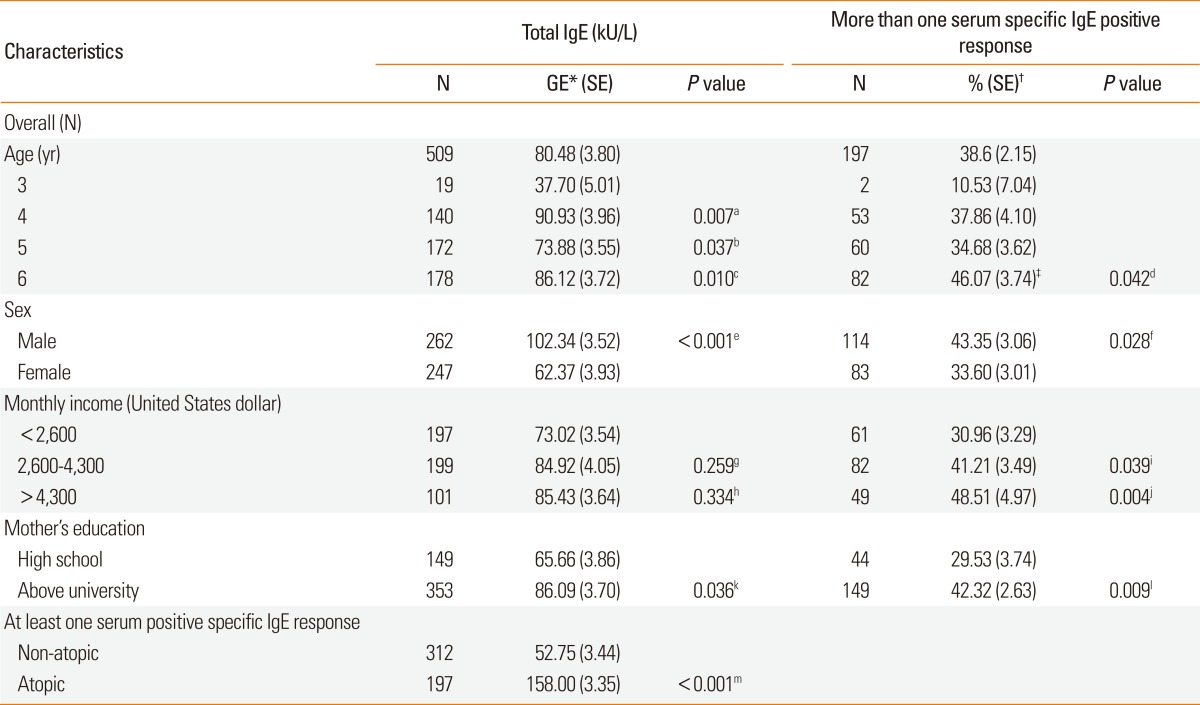
*GE: geometric mean; χ2 test for trend analysis; P value=0.370; †χ2 test for trend analysis; P value=0.028; ‡specific IgE % at age 5:6 yr; P value=0.043.
a: t-test of GE at age 3:4 yr; b: t-test of GE at age 3:5 yr; c: t-test of GE at age 3:6 yr; d: t-test of specific IgE % at age 3+4:6 yr; e: t-test of GE for sex; f: t-test of specific IgE % for sex; g: t-test of GE for income <2,600: 2,600-4,300; h: t-test of GE for income <2,600: >4,300; i: t-test of specific IgE % for income <2,600: 2,600-4,300; j: t-test of specific IgE % for income <2,600: >4,300; k: t-test of GE for mother's education high school: above university; l: t-test of specific IgE % for mother's education high school: above university; m: t-test of GE for at least one serum positive specific IgE Non-atopic: Atopic.
The highest prevalence of atopy was shown at age 6 years and increased according to age (P=0.028). Boys showed a higher atopy prevalence than girls. The prevalence of atopy was significantly lower in the group with a monthly income less than $2,600 as compared with other groups with a monthly income over $2,600. Additionally, total IgE levels (P=0.036) and the prevalence of atopy (P=0.009) were significantly higher in subjects with a maternal education above university level as compared with that in subjects with a maternal education level of high school.
Prevalence of allergen sensitization
The prevalence of serum specific IgE and positive skin test responses to the seven inhalant allergens among Korean preschool children aged 3 to 6 years is shown in Table 3. The prevalence of serum specific IgE to at least one allergen was higher (38.6%) than the prevalence of positive skin test responses (14.7%). The much lower prevalence of a positive skin test response to D. farinae, which is the major allergen that causes allergic responses in preschool children aged 3 to 6 years, lead to the discrepancy between the sensitization rates of the two methods (serum specific IgE, 36.5%; positive skin test responses, 13.0%). The second most prevalent serum specific IgE was to alder, followed by mugwort/A. alternata, cockroach, dog dander, and cat dander. The second most common positive skin test response was to dog dander, followed by alder/mugwort/cat dander, A. alternate, and cockroach. Excluding D. farinae, the positive response rates to six allergens were similar between the specific IgE test and SPT.
Table 3.
Prevalence of positive responses to SPTs and serum specific IgE tests among preschool children aged 3 to 6 years
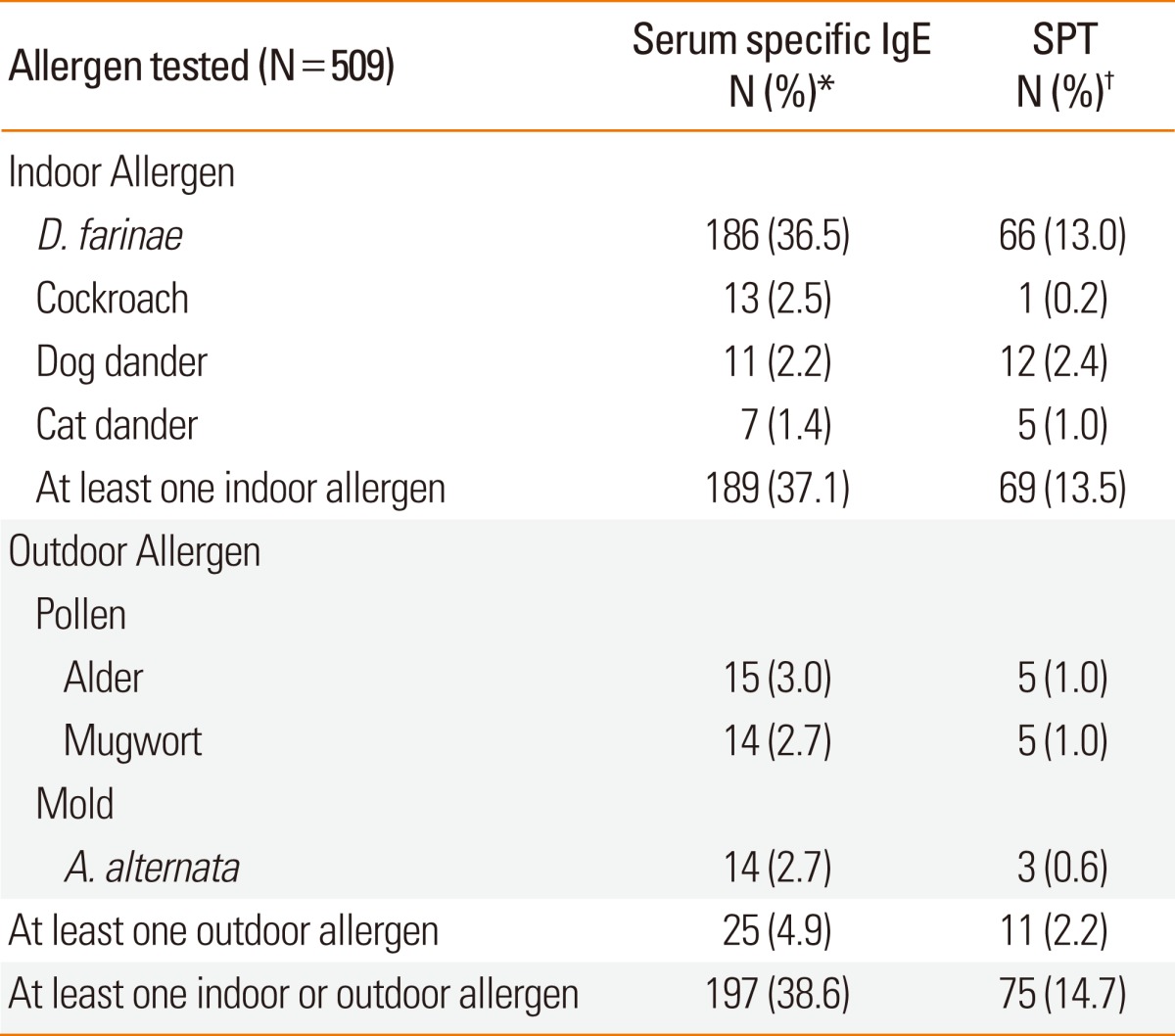
*Defined as allergen specific IgE ≥0.35 kU/L (≥class 1); †Defined as wheal size to allergen ≥3 mm and wheal size to allergen ≥wheal size to histamine. SPTs, skin prick tests; D. farinae, Dermatophagoides farinae; A. alternate, Alternaria alternate.
Percentile for total and specific serum IgE levels in preschool children
Total IgE levels were differed with age and sex (Fig. 1A). In boys, the geometric mean of the total IgE level was significantly higher than girls. Additionally, total IgE levels were constantly high across age groups (50th percentile: 102.00 kU/L at 3 years and 108.50 kU/L at 6 years). However, in girls, the total IgE level increased with age (90th percentile: 88.50 kU/L at 3 years and 517.50 kU/L at 6 years).
Fig. 1.
Percentile distribution of total and Der f specific IgE levels by age. (A) Percentile for total IgE levels at each age in preschool children. (B) Percentile for Der f specific IgE levels at each age in preschool children.
D. farinae was the most prevalent sensitized allergen in both boys (21.4%) and girls (15.1%). Particularly, serum-specific IgE levels rapidly increased in boys from age 3 to 4 years (90th percentile: 30.93 kU/L at 3 years and 61.00 kU/L at 4 years). However, in girls, serum specific IgE levels to D. farinae increased constantly with age (90th percentile: 0.07 kU/L at 3 years and 72.80 kU/L at 6 years) (Fig. 1B).
Relationship between allergic diseases and serum total or specific IgE levels at ages 3 to 6 years
The relationships between allergic diseases and total IgE levels are shown in Table 4. The relationship between total serum IgE-positive and physician-diagnosed atopic dermatitis is clearly shown (P=0.002); however, no significant association was found between allergic diseases and the parent's report. Additionally, as shown in Fig. 2, the prevalence of physician-diagnosed atopic dermatitis was proportional to the increase in total IgE levels (25th percentile, 7.8%; 50th percentile, 11.9%; 75th percentile, 15.6%; and 90th percentile, 21.4%, P<0.007).
Table 4.
Association between allergic disease and serum total/specific IgE at ages 3 to 6 years
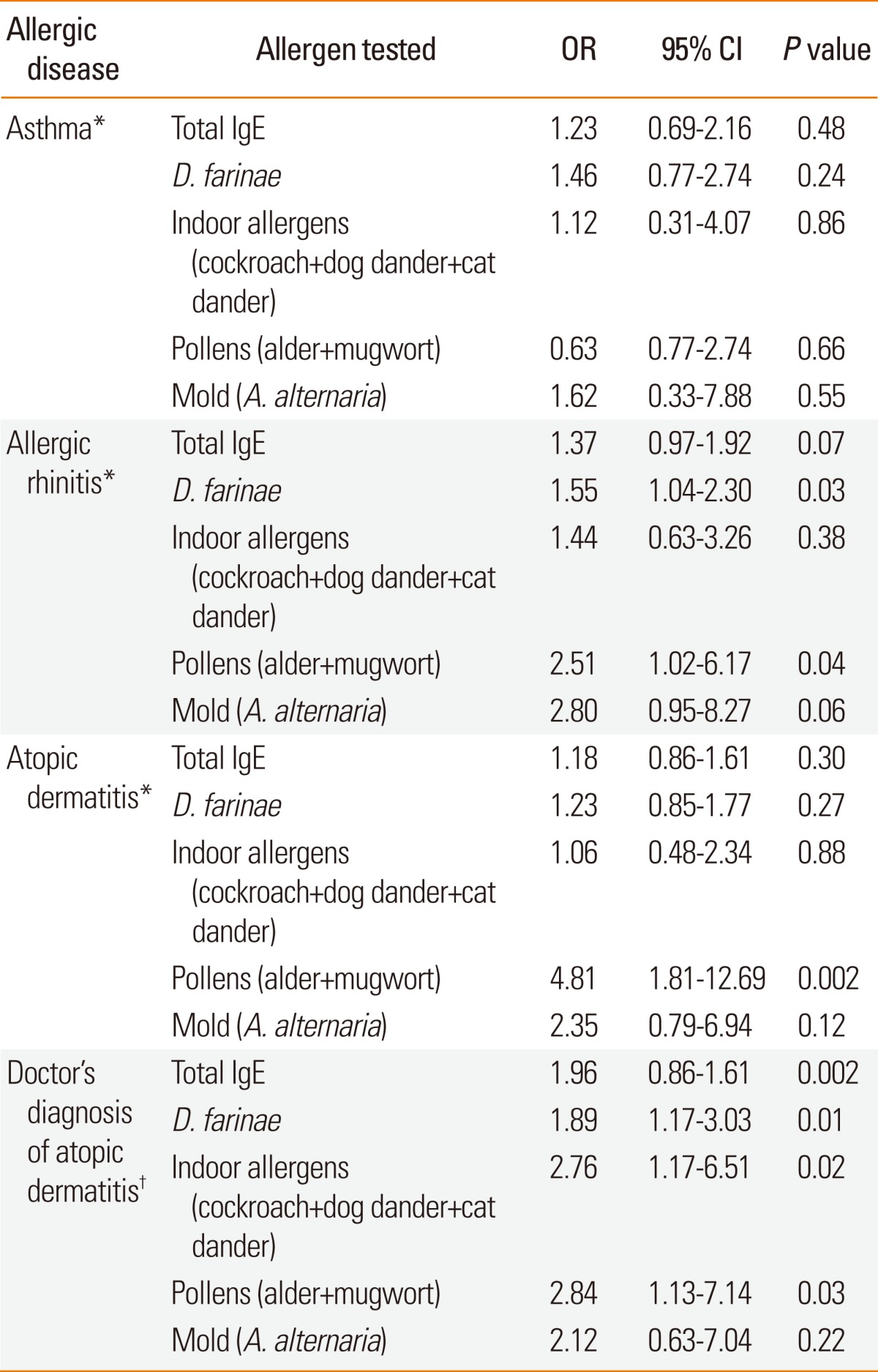
Adjusted for age, sex, monthly income, mother's education, and body mass index.
*Asthma, allergic rhinitis, and atopic dermatitis: diagnosis based on questionnaire; †Doctor's diagnosis of atopic dermatitis: eczema on doctor's examination. OR, odds ratio; CI, confidence intervals; D. farinae, Dermatophagoides farinae; A. alternate, Alternaria alternate.
Fig. 2.
Prevalence of allergic diseases by total IgE percentile. Physician-diagnosed atopic dermatitis (P=0.007).
The associations between allergic diseases and specific IgE were examined by multiple regression after adjustment for age, sex, income, and maternal education level (Table 2). Significant associations were noted between physician-diagnosed atopic dermatitis and sensitization to inhalant allergens (D. farinae, cockroach, dog, cat, alder, and mugwort). Atopic dermatitis based on the questionnaire was associated with pollen sensitization. Allergic rhinitis, but not asthma, was also related to D. farinae and pollen allergens (alder, mugwort). These results were the same after adjustment for a parental history of allergic diseases.
DISCUSSION
It is important to profile the distribution of serum total IgE levels and atopy prevalence based on positive responses to specific IgE or SPTs in the general population to understand atopic allergic diseases by country and region. Total IgE levels are affected not only by specific IgE, the key factor for distinguishing atopy and non-atopy, but also by various factors, such as age, sex, community, and geographical area.14,20-29 Particularly, information concerning the changes in total IgE level and sensitization rate to various allergens is very important to develop markers for allergic disease prevention and control, as well as to provide clinical recommendations to clinicians. This is the first study to show the distribution of the total IgE levels according to age, sex, and allergic disease in a population of preschool children aged 3 to 6 years in Korea.
Notably, serum specific IgE tests demonstrated a positive response rate higher than that of SPTs (serum specific IgE tests, 38.6%; SPTs, 14.7%). This may be due to the difference in the positive response rate to D. farinae (serum specific IgE tests, 37.1%; SPTs, 13.5%). Although further investigations are needed to determine the key factors that evoke the difference between the two methods, a higher positive response rate may be attributed to a higher sensitivity of serum specific IgE tests than SPTs.31,32 Although we did not describe the comparison between SPTs and serum specific IgE tests throughout the age range in the present study, we examined and analyzed the atopy prevalence from age 10 years to that above age 70 years using the Korea National Health and Nutrition Examination Survey (KNHANES 2011) and Ansung Cohort study in 2011. In those studies, the atopy prevalence was higher for serum specific IgE tests than for SPTs at the age range showing a low concentration of serum specific IgE. However, the atopy prevalence at the age range showing a high concentration of serum specific IgE was similar between both methods and even slightly higher for SPTs. In fact, serum specific IgE levels to D. farinae were low at ages 3 to 6 years as compared with other age ranges in the KNHANES and Ansung Cohort subjects (data not shown). Thus, the higher positive rate of serum specific IgE tests might be due to the high sensitivity of the test with a low concentration of serum specific IgE at ages 3 to 6 years.
Remarkably, the total IgE level of preschool children was very high as compared with previous reports from other countries, such as European countries9 and the United States.30 Conversely, the positive serum specific IgE response to one or more allergens among the seven allergens was lower than that in the United States, with a wide range of ages above 10 years (45.2%).30 Additionally, when comparing total IgE levels for atopic and non-atopic groups with other studies, the positive serum specific IgE values were high in both the non-atopic and atopic Korean children subjects, indicating a lower atopy prevalence and higher level of serum total IgE in Korea as compared with that in the United States. The cause may be due to differences in age or ethnicity.30,33-35 Further studies are needed to understand why serum total IgE levels are so high in Korean children.
Notably, subjects with higher maternal education levels or a higher household income had increased total IgE levels, a finding that is quite different from that in previous studies showing an association between low socioeconomic status (SES) and higher total IgE in adults.30,34 The relationship among SES, total IgE, and atopy prevalence is controversial. Some studies have reported that a lower SES is related to a higher prevalence of atopy and total IgE or even to a higher asthma prevalence in adults30,34,36; however, other studies have found that only a high atopy rate was associated with higher social class,37,38 a finding that is somewhat consistent with ours. These discrepancies suggest that total IgE production might be affected by more complex factors than are currently thought.
With respect to sex, the present study also showed higher total IgE levels in boys; it is generally accepted that total IgE levels are higher in boys and men.30,39-43 Particularly, total IgE levels in girls increased with age from 3 to 6 years, while that in boys reached a plateau from 3 to 6 years. This finding implies that total IgE development is slower in girls than boys, resulting in a lower prevalence of specific IgE in girls (boys, 43.35±3.06%; girls, 33.60±3.01%; P=0.028).
In the present study, a significant association between total IgE levels and allergic disease was shown only in physician-diagnosed atopic dermatitis, not in cases of allergic diseases based on the parent's questionnaire. For specific IgE, atopic dermatitis and allergic rhinitis based on the questionnaire was associated with specific IgE to pollen and D. farinae, respectively. However, asthma based on the questionnaire did not show an association with any serum specific IgE to the seven allergens. Thus, asthma did not appear to be associated with total or specific IgE levels, which might be due to several reasons. Because asthma, rhinitis, and eczema are categorized into two groups according to the presence of serum specific IgE, i.e., non-atopic or atopic, IgE levels cannot be simply defined as being related to asthma. Additionally, in the present study, the small number of asthma cases as compared with other cases (asthma, n=39; allergic rhinitis, n=137; atopic dermatitis, n=183), as well as the imprecise definition of asthma in children ages less than 6 years, might affect the results.
Despite the importance of knowledge regarding total and specific IgE levels in preschool children, no significant data previously existed in Koreans because these ages could not be properly surveyed. In the present study, we analyzed total and specific IgE levels and SPTs in 509 children with epidemiological data. The results of this study represent at least a specific group, i.e., 3- to 6-year-old preschool children in Seoul, Korea, which may be useful as a reference value. Additionally, the high response rate of our questionnaire survey (93.3%) allowed us to minimize biases to better understand epidemiological characteristics of this age group.
In summary, total IgE levels were extremely high in both atopic and non-atopic children as compared with previous data from other countries. Household income and maternal education level were also important factors for total IgE levels and the presence of atopy. The most prevalent allergen was D. farinae, and over 10.5% of children were sensitized to D. farinae at 3 years of age. Although further investigations are needed regarding total IgE production and sensitization to various allergens in children across a wide age range and with various environmental factors including infection, the total and specific IgE values and distribution in general preschool children described in the current study will be helpful not only to understand allergic sensitization and total IgE production, but also to support the diagnosis and treatment of allergic diseases as a reference value.
ACKNOWLEDGMENTS
This study was supported by a grant from the Korea Healthcare Technology R&D Project, Ministry of Health & Welfare, Republic of Korea (A092076).
Footnotes
There are no financial or other issues that might lead to conflict of interest.
References
- 1.Gustafsson D, Sjöberg O, Foucard T. Development of allergies and asthma in infants and young children with atopic dermatitis--a prospective follow-up to 7 years of age. Allergy. 2000;55:240–245. doi: 10.1034/j.1398-9995.2000.00391.x. [DOI] [PubMed] [Google Scholar]
- 2.Stupka E, deShazo R. Asthma in seniors: Part 1. Evidence for underdiagnosis, undertreatment, and increasing morbidity and mortality. Am J Med. 2009;122:6–11. doi: 10.1016/j.amjmed.2008.09.022. [DOI] [PubMed] [Google Scholar]
- 3.Burgess JA, Dharmage SC, Byrnes GB, Matheson MC, Gurrin LC, Wharton CL, Johns DP, Abramson MJ, Hopper JL, Walters EH. Childhood eczema and asthma incidence and persistence: a cohort study from childhood to middle age. J Allergy Clin Immunol. 2008;122:280–285. doi: 10.1016/j.jaci.2008.05.018. [DOI] [PubMed] [Google Scholar]
- 4.Stern DA, Morgan WJ, Halonen M, Wright AL, Martinez FD. Wheezing and bronchial hyper-responsiveness in early childhood as predictors of newly diagnosed asthma in early adulthood: a longitudinal birth-cohort study. Lancet. 2008;372:1058–1064. doi: 10.1016/S0140-6736(08)61447-6. [DOI] [PMC free article] [PubMed] [Google Scholar]
- 5.Martin PE, Matheson MC, Gurrin L, Burgess JA, Osborne N, Lowe AJ, Morrison S, Mészáros D, Giles GG, Abramson MJ, Walters EH, Allen KJ, Dharmage SC. Childhood eczema and rhinitis predict atopic but not nonatopic adult asthma: a prospective cohort study over 4 decades. J Allergy Clin Immunol. 2011;127:1473–1479.e1. doi: 10.1016/j.jaci.2011.02.041. [DOI] [PubMed] [Google Scholar]
- 6.The International Study of Asthma and Allergies in Childhood (ISAAC) Steering committee. Steering committee. Worldwide variation in prevalence of symptoms of asthma, allergic rhinoconjunctivitis, and atopic eczema: ISAAC. Lancet. 1998;351:1225–1232. [PubMed] [Google Scholar]
- 7.Ellwood P, Asher MI, Beasley R, Clayton TO, Stewart AW ISAAC Steering Committee. The international study of asthma and allergies in childhood (ISAAC): phase three rationale and methods. Int J Tuberc Lung Dis. 2005;9:10–16. [PubMed] [Google Scholar]
- 8.Hamilton RG. Assessment of human allergic diseases. In: Rich RR, Fleisher TA, Shearer WT, Schroeder HW Jr, Frew AJ, Weyand CM, editors. Clinical immunology: principles and practice. 3rd ed. London: Mosby Elsevier Ltd; 2008. pp. 1471–1484. [Google Scholar]
- 9.Carosso A, Bugiani M, Migliore E, Antò JM, DeMarco R. Reference values of total serum IgE and their significance in the diagnosis of allergy in young European adults. Int Arch Allergy Immunol. 2007;142:230–238. doi: 10.1159/000097025. [DOI] [PubMed] [Google Scholar]
- 10.Zetterström O, Johansson SG. IgE concentrations measured by PRIST in serum of healthy adults and in patients with respiratory allergy. A diagnostic approach. Allergy. 1981;36:537–547. doi: 10.1111/j.1398-9995.1981.tb01871.x. [DOI] [PubMed] [Google Scholar]
- 11.Criqui MH, Seibles JA, Hamburger RN, Coughlin SS, Gabriel S. Epidemiology of immunoglobulin E levels in a defined population. Ann Allergy. 1990;64:308–313. [PubMed] [Google Scholar]
- 12.Grigoreas C, Pappas D, Galatas ID, Kollias G, Papadimos S, Papadakis P. Serum total IgE levels in a representative sample of a Greek population. I. Correlation with age, sex, and skin reactivity to common aeroallergens. Allergy. 1993;48:142–146. doi: 10.1111/j.1398-9995.1993.tb00703.x. [DOI] [PubMed] [Google Scholar]
- 13.Jarvis D, Luczynska C, Chinn S, Burney P. The association of age, gender and smoking with total IgE and specific IgE. Clin Exp Allergy. 1995;25:1083–1091. doi: 10.1111/j.1365-2222.1995.tb03255.x. [DOI] [PubMed] [Google Scholar]
- 14.Burney P, Malmberg E, Chinn S, Jarvis D, Luczynska C, Lai E. The distribution of total and specific serum IgE in the European Community Respiratory Health Survey. J Allergy Clin Immunol. 1997;99:314–322. doi: 10.1016/s0091-6749(97)70048-4. [DOI] [PubMed] [Google Scholar]
- 15.Kjellman NI, Nilsson L. From food allergy and atopic dermatitis to respiratory allergy. Pediatr Allergy Immunol. 1998;9:13–17. [PubMed] [Google Scholar]
- 16.Sigurs N, Hattevig G, Kjellman B, Kjellman NI, Nilsson L, Björkstén B. Appearance of atopic disease in relation to serum IgE antibodies in children followed up from birth for 4 to 15 years. J Allergy Clin Immunol. 1994;94:757–763. doi: 10.1016/0091-6749(94)90184-8. [DOI] [PubMed] [Google Scholar]
- 17.Burr ML, Merrett TG, Dunstan FD, Maguire MJ. The development of allergy in high-risk children. Clin Exp Allergy. 1997;27:1247–1253. [PubMed] [Google Scholar]
- 18.Kulig M, Bergmann R, Tacke U, Wahn U, Guggenmoos-Holzmann I. Long-lasting sensitization to food during the first two years precedes allergic airway disease. The MAS Study Group, Germany. Pediatr Allergy Immunol. 1998;9:61–67. doi: 10.1111/j.1399-3038.1998.tb00305.x. [DOI] [PubMed] [Google Scholar]
- 19.Kurukulaaratchy RJ, Matthews S, Arshad SH. Defining childhood atopic phenotypes to investigate the association of atopic sensitization with allergic disease. Allergy. 2005;60:1280–1286. doi: 10.1111/j.1398-9995.2005.00890.x. [DOI] [PubMed] [Google Scholar]
- 20.Song Y, Kwon JW, Kim BJ, Kim BS, Kim JH, Kim HB, Lee SY, Yu J, Yu SM, Hong SJ. Relationship between allergic rhinitis and asthma in high school students in Korea. Pediatr Allergy Respir Dis. 2010;20:30–40. [Google Scholar]
- 21.Kwon JW, Seo JH, Yu J, Kim BJ, Kim HB, Lee SY, Kim WK, Kim KW, Ji HM, Kim KE, Shin YJ, Kim MH, Kim H, Hong SJ. Relationship between the prevalence of allergic rhinitis and allergen sensitization in children of Songpa area, Seoul. Pediatr Allergy Respir Dis. 2011;21:47–55. [Google Scholar]
- 22.Mediaty A, Neuber K. Total and specific serum IgE decreases with age in patients with allergic rhinitis, asthma and insect allergy but not in patients with atopic dermatitis. Immun Ageing. 2005;2:9. doi: 10.1186/1742-4933-2-9. [DOI] [PMC free article] [PubMed] [Google Scholar]
- 23.Barbee RA, Brown WG, Kaltenborn W, Halonen M. Allergen skin-test reactivity in a community population sample: correlation with age, histamine skin reactions and total serum immunoglobulin E. J Allergy Clin Immunol. 1981;68:15–19. doi: 10.1016/0091-6749(81)90117-2. [DOI] [PubMed] [Google Scholar]
- 24.Barbee RA, Halonen M, Lebowitz M, Burrows B. Distribution of IgE in a community population sample: correlations with age, sex, and allergen skin test reactivity. J Allergy Clin Immunol. 1981;68:106–111. doi: 10.1016/0091-6749(81)90167-6. [DOI] [PubMed] [Google Scholar]
- 25.Barbee RA, Halonen M, Kaltenborn W, Lebowitz M, Burrows B. A longitudinal study of serum IgE in a community cohort: correlations with age, sex, smoking, and atopic status. J Allergy Clin Immunol. 1987;79:919–927. doi: 10.1016/0091-6749(87)90241-7. [DOI] [PubMed] [Google Scholar]
- 26.Barbee RA, Kaltenborn W, Lebowitz MD, Burrows B. Longitudinal changes in allergen skin test reactivity in a community population sample. J Allergy Clin Immunol. 1987;79:16–24. doi: 10.1016/s0091-6749(87)80010-6. [DOI] [PubMed] [Google Scholar]
- 27.Freidhoff LR, Meyers DA, Bias WB, Chase GA, Hussain R, Marsh DG. A genetic-epidemiologic study of human immune responsiveness to allergens in an industrial population: I. Epidemiology of reported allergy and skin-test positivity. Am J Med Genet. 1981;9:323–340. doi: 10.1002/ajmg.1320090409. [DOI] [PubMed] [Google Scholar]
- 28.Freidhoff LR, Meyers DA, Marsh DG. A genetic-epidemiologic study of human immune responsiveness to allergens in an industrial population. II. The associations among skin sensitivity, total serum IgE, age, sex, and the reporting of allergies in a stratified random sample. J Allergy Clin Immunol. 1984;73:490–499. doi: 10.1016/0091-6749(84)90360-9. [DOI] [PubMed] [Google Scholar]
- 29.Arbes SJ, Jr, Gergen PJ, Elliott L, Zeldin DC. Prevalences of positive skin test responses to 10 common allergens in the US population: results from the third National Health and Nutrition Examination Survey. J Allergy Clin Immunol. 2005;116:377–383. doi: 10.1016/j.jaci.2005.05.017. [DOI] [PubMed] [Google Scholar]
- 30.Gergen PJ, Arbes SJ, Jr, Calatroni A, Mitchell HE, Zeldin DC. Total IgE levels and asthma prevalence in the US population: results from the National Health and Nutrition Examination Survey 2005-2006. J Allergy Clin Immunol. 2009;124:447–453. doi: 10.1016/j.jaci.2009.06.011. [DOI] [PMC free article] [PubMed] [Google Scholar]
- 31.Pastorello EA, Incorvaia C, Ortolani C, Bonini S, Canonica GW, Romagnani S, Tursi A, Zanussi C. Studies on the relationship between the level of specific IgE antibodies and the clinical expression of allergy: I. Definition of levels distinguishing patients with symptomatic from patients with asymptomatic allergy to common aeroallergens. J Allergy Clin Immunol. 1995;96:580–587. doi: 10.1016/s0091-6749(95)70255-5. [DOI] [PubMed] [Google Scholar]
- 32.Ricci G, Capelli M, Miniero R, Menna G, Zannarini L, Dillon P, Masi M. A comparison of different allergometric tests, skin prick test, Pharmacia UniCAP and ADVIA Centaur, for diagnosis of allergic diseases in children. Allergy. 2003;58:38–45. doi: 10.1034/j.1398-9995.2003.23761.x. [DOI] [PubMed] [Google Scholar]
- 33.Grundbacher FJ, Massie FS. Levels of immunoglobulin G, M, A, and E at various ages in allergic and nonallergic black and white individuals. J Allergy Clin Immunol. 1985;75:651–658. doi: 10.1016/0091-6749(85)90089-2. [DOI] [PubMed] [Google Scholar]
- 34.Litonjua AA, Celedón JC, Hausmann J, Nikolov M, Sredl D, Ryan L, Platts-Mills TA, Weiss ST, Gold DR. Variation in total and specific IgE: effects of ethnicity and socioeconomic status. J Allergy Clin Immunol. 2005;115:751–757. doi: 10.1016/j.jaci.2004.12.1138. [DOI] [PubMed] [Google Scholar]
- 35.Wittig HJ, Belloit J, De Fillippi I, Royal G. Age-related serum immunoglobulin E levels in healthy subjects and in patients with allergic disease. J Allergy Clin Immunol. 1980;66:305–313. doi: 10.1016/0091-6749(80)90026-3. [DOI] [PubMed] [Google Scholar]
- 36.Moorman JE, Zahran H, Truman BI, Molla MT Centers for Disease Control and Prevention (CDC) Current asthma prevalence - United States, 2006-2008. MMWR Surveill Summ. 2011;60(Suppl):84–86. [PubMed] [Google Scholar]
- 37.Heinrich J, Popescu MA, Wjst M, Goldstein IF, Wichmann HE. Atopy in children and parental social class. Am J Public Health. 1998;88:1319–1324. doi: 10.2105/ajph.88.9.1319. [DOI] [PMC free article] [PubMed] [Google Scholar]
- 38.Baqueiro T, Pontes-de-carvalho L, Carvalho FM, Santos NM, Alcântara-Neves NM Medical Student's Group. Asthma and rhinitis symptoms in individuals from different socioeconomic levels in a Brazilian city. Allergy Asthma Proc. 2007;28:362–367. doi: 10.2500/aap.2007.28.2967. [DOI] [PubMed] [Google Scholar]
- 39.Omenaas E, Bakke P, Elsayed S, Hanoa R, Gulsvik A. Total and specific serum IgE levels in adults: relationship to sex, age and environmental factors. Clin Exp Allergy. 1994;24:530–539. doi: 10.1111/j.1365-2222.1994.tb00950.x. [DOI] [PubMed] [Google Scholar]
- 40.Kerkhof M, Droste JH, de Monchy JG, Schouten JP, Rijcken B. Distribution of total serum IgE and specific IgE to common aeroallergens by sex and age, and their relationship to each other in a random sample of the Dutch general population aged 20-70 years. Dutch ECRHS Group, European Community Respiratory Health Study. Allergy. 1996;51:770–776. doi: 10.1111/j.1398-9995.1996.tb00021.x. [DOI] [PubMed] [Google Scholar]
- 41.Wuthrich B, Schindler C, Medici TC, Zellweger JP, Leuenberger P. IgE levels, atopy markers and hay fever in relation to age, sex and smoking status in a normal adult Swiss population. SAPALDIA (Swiss Study on Air Pollution and Lung Diseases in Adults) Team. Int Arch Allergy Immunol. 1996;111:396–402. doi: 10.1159/000237398. [DOI] [PubMed] [Google Scholar]
- 42.Kulig M, Tacke U, Forster J, Edenharter G, Bergmann R, Lau S, Wahn V, Zepp F, Wahn U. Serum IgE levels during the first 6 years of life. J Pediatr. 1999;134:453–458. doi: 10.1016/s0022-3476(99)70203-9. [DOI] [PubMed] [Google Scholar]
- 43.Malinowska E, Kaczmarski M. Total IgE levels in children under three years of age. Med Sci Monit. 2002;8:CR113–CR118. [PubMed] [Google Scholar]



